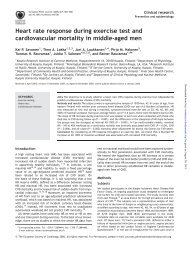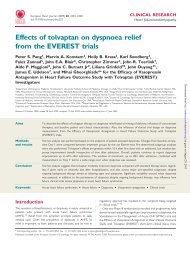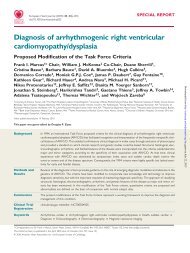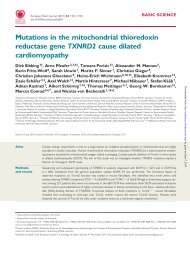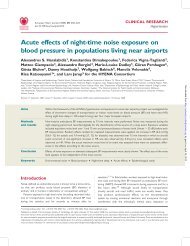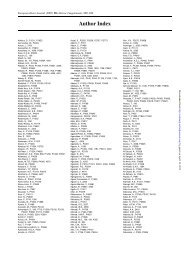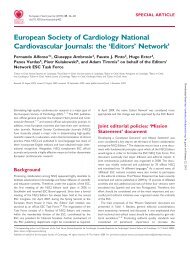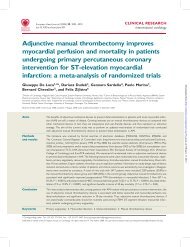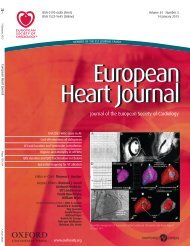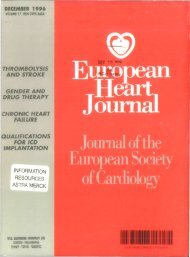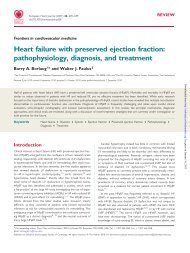- Page 1 and 2: Monday, 1 September 2008 Downloaded
- Page 3 and 4: CAN WE PREDICT ATRIAL FIBRILLATION?
- Page 5: Thromboembolic risks and therapeuti
- Page 9 and 10: NEW PROGNOSTIC MARKERS IN ACUTE CAR
- Page 11 and 12: CI 0.2-1.6, p=0.32) after epinephri
- Page 13 and 14: Risk assessment: strengths and weak
- Page 15 and 16: Prognosis in heart failure: surveys
- Page 17 and 18: Restenosis: is there an alternative
- Page 19 and 20: Confonding factors influencing outc
- Page 21 and 22: New vessels and changed vessels: an
- Page 23 and 24: (n=574) served as the cohort where
- Page 25 and 26: Using Cox’s proportional hazards
- Page 27 and 28: hibitory response, or in pts with p
- Page 29 and 30: Multimodality imaging of coronary h
- Page 31 and 32: Conclusions: EVH is a strong indepe
- Page 33 and 34: any antiarrhythmic drug (AAD), Grou
- Page 35 and 36: oxidases decreased O2- by 16±3.1%
- Page 37 and 38: Fig. 1. Five types of merge errors.
- Page 39 and 40: manent AF were studied. The number
- Page 41 and 42: P1933 Left atrial appendage dominan
- Page 43 and 44: hydrolysable, it would dissipate be
- Page 45 and 46: P1949 A first-in-human clinical tri
- Page 47 and 48: P1957 Electrophysiological effects
- Page 49 and 50: for the population of Tayside, Scot
- Page 51 and 52: P1973 Effect of ursodeoxycholic aci
- Page 53 and 54: =0.31, p=0.0003) and QUICKI (r=0.29
- Page 55 and 56: P1989 Hormonal mechanisms of cachex
- Page 57 and 58:
or more of the following ECG change
- Page 59 and 60:
P2004 Association between cardiovas
- Page 61 and 62:
P2012 Correlations between the degr
- Page 63 and 64:
disease. Familial study was recomen
- Page 65 and 66:
P2027 MRI for the detection of rest
- Page 67 and 68:
P2035 Oxidized low density lipoprot
- Page 69 and 70:
P2042 Persistent under representati
- Page 71 and 72:
P2049 Addition of B-type natriureti
- Page 73 and 74:
P2058 Genetic variation in CYP2C19
- Page 75 and 76:
p=0.003). Minor bleeding was also l
- Page 77 and 78:
Avidin, a protein found in hen eggs
- Page 79 and 80:
flow, and
- Page 81 and 82:
(PCWP) were recorded. In 16 patient
- Page 83 and 84:
Methods: A prospective, consecutive
- Page 85 and 86:
over paclitaxel-eluting stent (PES)
- Page 87 and 88:
which proved to be safe and effecti
- Page 89 and 90:
Comparison of neointimal growth amo
- Page 91 and 92:
patients between October 2006 and J
- Page 93 and 94:
P2139 Inverse relation of baseline
- Page 95 and 96:
tive. We sought to determine the ef
- Page 97 and 98:
P2155 A very high prevalence of low
- Page 99 and 100:
P2163 The influence of estradiol on
- Page 101 and 102:
2nd year of follow-up, respectively
- Page 103 and 104:
P2179 Symptoms of atrial fibrillati
- Page 105 and 106:
P2187 The relationships of ambulato
- Page 107 and 108:
tension (WCHT) to vascular damage i
- Page 109 and 110:
in the postero- and midseptal regio
- Page 111 and 112:
elevation myocardial infarction (AM
- Page 113 and 114:
assigned to receive either unselect
- Page 115 and 116:
was injected. Left ventricular func
- Page 117 and 118:
of MACE in patients with LGE and de
- Page 119 and 120:
P2243 Blood oxygenation level-depen
- Page 121 and 122:
P2250 Prognostic value of revascula
- Page 123 and 124:
needed to achieve 90% of age-predic
- Page 125 and 126:
presence/absence of VIVC assessed u
- Page 127 and 128:
2341 Telemonitoring in an elderly,
- Page 129 and 130:
Heart failure with preserved systol
- Page 131 and 132:
the most dilated, LA mostly influen
- Page 133 and 134:
Conclusion: In patients with stable
- Page 135 and 136:
2388 Magnitude of glycaemia variati
- Page 137 and 138:
patients with RV > 30 ml this corre
- Page 139 and 140:
BIOMARKERS: NEW KIDS ON THE BLOCK 2
- Page 141 and 142:
the importance of calling the emerg
- Page 143 and 144:
Sudden death, devices and public aw
- Page 145 and 146:
Bone marrow progenitors: filling th
- Page 147 and 148:
2566 Esophageal capsule endoscopy i
- Page 149 and 150:
(7.0%) patients receiving aliskiren
- Page 151 and 152:
P2600 Final aggregation response is
- Page 153 and 154:
Results: Female patients (27.7%) we
- Page 155 and 156:
with atrial fibrillation (AF) under
- Page 157 and 158:
e feasible and safe. This approach
- Page 159 and 160:
coagulant therapy (P=0.038; OR=2.42
- Page 161 and 162:
ison between responders and nonresp
- Page 163 and 164:
Table 1. Systolic, diastolic and dy
- Page 165 and 166:
Syncope and cardiac pacing: miscell
- Page 167 and 168:
their downstream effector, myosin h
- Page 169 and 170:
Understanding determinants of hemod
- Page 171 and 172:
the abundance of profibrotic CCN2 p
- Page 173 and 174:
parison with IL-8 as well as the ex
- Page 175 and 176:
and EF (-0.5%) which significantly
- Page 177 and 178:
of effects on systemic BP and cardi
- Page 179 and 180:
Conclusion: Compared to previously
- Page 181 and 182:
P2723 Differential virus-associated
- Page 183 and 184:
Methods: During 2007, 10 patients (
- Page 185 and 186:
cardiomyocyte apoptosis was highest
- Page 187 and 188:
higher for NT-proBNP (area under th
- Page 189 and 190:
or higher) in 85 patients (4.2%). M
- Page 191 and 192:
teria as a final Thrombolysis In My
- Page 193 and 194:
cantly correlated to in-hospital de
- Page 195 and 196:
nosis in patients with myocardial i
- Page 197 and 198:
lesion classification, stent type u
- Page 199 and 200:
Prognosis in ST-elevation myocardia
- Page 201 and 202:
P2802 In-hospital and long-term mor
- Page 203 and 204:
P2810 Long-term clinical results fo
- Page 205 and 206:
Percutaneous coronary intervention;
- Page 207 and 208:
vessels (DES 16.7%, BMS 6.7%, p=0.0
- Page 209 and 210:
patients receiving a DES and the ra
- Page 211 and 212:
Results: The two groups had similar
- Page 213 and 214:
among their non-DM counterparts (HR
- Page 215 and 216:
tigated the long-term consequences
- Page 217 and 218:
culogenesis. Reduction of VPC and E
- Page 219 and 220:
y echo-tracking technique calibrate
- Page 221 and 222:
P2885 Statins are effective in redu
- Page 223 and 224:
Conclusions: The patient-centred he
- Page 225 and 226:
P2900 Should left ventricular hyper
- Page 227 and 228:
P2908 Telmisartan up-regulates the
- Page 229 and 230:
important sex-based differences in
- Page 231 and 232:
Hypertension: regional and ethnic p
- Page 233 and 234:
whether the selective mineralocorti
- Page 235 and 236:
THE ENDOTHELIUM: AT THE HEART OF VA
- Page 237 and 238:
P2951 Reproducibility of endothelia
- Page 239 and 240:
P2959 Brachial flow-mediated dilati
- Page 241 and 242:
P2966 Detection of late enhancement
- Page 243 and 244:
tissue as an enhanced area. On the
- Page 245 and 246:
dial dysfunction is critical for th
- Page 247 and 248:
for testing the load dependence. Th
- Page 249:
diastolic velocity (-12.3±4.9 vs -



